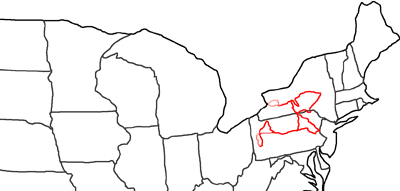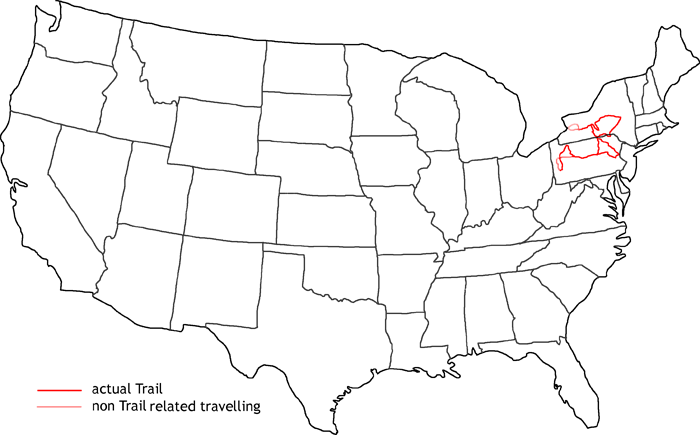Sullivan, Clinton and Broadhead Trail 1779


Map of Sullivan, Clinton and Broadhead Trail
My year 2000 travelings get me from Pittsburgh to the East of Pennsylvania, to Easton, north of Philadelphia. From there I travel on in northeasterly direction into the State of New York and to the Finger Lakes. Via Syracuse I reach the Mohawk Valley. A short distance past Herkimer I go on in southwesterly direction and follow the Susquehanna River back to Waverly/Elmira. Then I travel up north to Niagara Falls. The end of my travel get me to Salamanca and along the Allegheny River back to Pittsburgh.
I follow the trails of General John Sullivan, James Clinton and Daniel Broadhead. They had the order from General George Washington to destroy all Indian settlements and provisions along their way. The goal of this expedition was to weaken the alliance of the Iroquois Indians. This goal was reached by the sudden food dependency of the Indians from the British.
The idea behind was simple: Sullivan should collect his troops at Easton and follow the Susquehanna River up to the Northwest. At the same time Clinton should follow the Susquehanna to the southwest from the Mohawk Valley. Both forces should reunite at Tioga. From there they should enter the Iroquios territory and destroy all crop and houses. At the same time, Broadhead should follow the Allegheny River from Pittsburgh and destroy everything along his route.
The main problem of this expedition was the supply with food. Even before they planned to leave Easton, they had a couple of delays. Additionally the route from Easton to Wyoming was impassable for a certain time. So they had to wait until Juny 12th, 1779, until they reached Wyoming, way behind their schedule. This endangered the plan to do surprising attacks on the Indians. When they were on their way up the Susquehanna, the Bristish Commander Colonel John Butler learned about this rebel troop. He knew, that he was not able to withstand them. So he asked for assistance from Ft. Niagara. In the meantime, Sullivan waited at Wyoming for supplies. Every day, boats with supplies arrived, but he had to wait for more. End of July, George Washington lost his patience and ordered to march. Otherwise it would make no sense anymore. Just before this order reached Sullivan, he was on his way to Tioga. All the way, they were in danger of a sudden attack, but they reached Tioga on August 11th without a single fight. Sullivan sent out scouts to Chemung, north of Tioga. They leraned that around 300 Iroquois’ were either on the way to destroy their settlement or prepare for an attack. Sullivan ordered a night march, where they lost a couple of soldiers in the dark brush. When they reached Chemung, the settlement was already abandoned. They destroyed around 40 houses and the crop. Then they followed the Indian path for a short distance. On an open field, a short fight started. They marched back to Tioga, doing 40 miles in 24 hours. They lost 7 soldiers in the battle and 13 were wounded.
Clinton waited nearly a month at Lake Otsego. Sullivan sent Hand’s 900 soldiers to him. They destroyed on their way everything, they could reach. On August 19th, both forces united. On August 26th, the whole force of 4500 soldiers left Tioga. On August 28th, they reached what was left of Chemung. In the meantime Butler and the Mohawk Chief Joseph Brant prepared an ambush at Newton. The plan was, that they would attack Sullivan’s party from both sides and to start a panic under the soldiers. In the morning of August 29th, Sullivan’s scouts reached the ambush. They were able to warn Sullivan in time. At 11 o’clock, Sullivan reached the place and ordered to surround the enemies to attack them from behind. At 3pm the attack started. Unfortunately the soldiers were caught by a swamp while surrounding the enemies. So they were not yet at there positions, when Sullivan started the fight. When they reached the scene, the fight already started. When the enemies saw, that there were more attackers from the other side, the Indians fled and left the battlefield to the Americans. They destroyed Newton and burned down the whole crop. Sullivan decided to send back the heavy artillery, because this would keep him up. Next he reduced his supplies, because they planned to use the crop from the Indians. On August 31st, he ordered again a night march, which should catch up the Indians, who most likely fled to Catherine’s Town. This march was a nightmare! They had to march through extreme difficult country and a lot of swamps. At dawn they reached the town, which was already abandoned. Again, they destroyed everything. After one day of recovery, they marched on along the shores of Seneca Lake to Kendaia. On September 5th, they reached the city, which was also abandoned. In some places, there were even the pots still in the fire, which showed a sudden departure. The next destination was Canadasaga, the biggest town with 60 houses. But against all informations, also this city was abandoned. On September 10th, they reached Canandaigua, one of the most beautiful cities. Again they destroyed everything. One day later, they reached the little town Honeaye. There they surprised a couple of Indians, who were able to flee. Now they were close to their final destination, Genesee Castle. Therefore, Sullivan sent Lieutenant Thomas Boyd to Genesee, to explore the region. At first, he should only get 3 soldiers, but he insisted on 26. They made good progress, but then they got lost. They attacked a little village north of Genesse. Then he sent a message to Sullivan, that they would wait here for them. But he changed his mind and on September 13th, he marched on. He got into an ambush with 400 attackers. He had no chance against this superiority. When Sullivan heard the shooting, he tried to catch up to Boyd as fast as possible. He was able to drive the attackers away, but Boyd’s command was extinguished and a couple of his men, including Boyd, was missed. This mistake of Boyd at first glance had safed the life of hundreds of soldiers. If he wouldn’t be the one, who was captured by the ambush, the main force would have been attacked. Sullivan marched on immediately to Genesee. On the afternoon of September 14th, he reached the also abandoned city. At the center they found the horrible mutilated bodies of Boyd and his missed soldiers.
Within two days, they destroyed the city. Now they could start their march back. The Indians fled to Fort Niagara, fearing Sullivan would follow them. But he marched back to Seneca Lake with his troops. Now that the thread by the Iroquois’ was nearly over, he was able to divorce his troops to destroy the rest of the area. Colonel Peter Ganesvoort together with 100 soldiers should march to the East into the Mohawk Valley and destroy everything on his way to Albany. Colonel Henry Dearborn together with 700 soldiers should march along the west shores of Cayuga Lake to the south, while Colonel Walter Butler together with 500 soldiers should march along the east shores. They should meet with Sullivan again at Tioga. Colonel William Smith went down south along the west shores of Seneca Lake while Sullivan went down on the east shore together with the remaining troops. On September 30th, they all reached Wyoming. George Washington congratulated the troops to their big success. The Indians had no food and were now dependent from the British. This weakened the power of the British in the area dramatically. At the end of the war, most of the Iroquois’ Indian territory would be taken over by the Americans.
Follow me now on my daily trails:
- Day 1: September 3rd, 2000 Munich — Pittsburgh
- Day 2: September 4th, 2000 Pittsburgh (Family Reunion)
- Day 3: September 5th, 2000 Pittsburgh (Car Search)
- Day 4: September 6th, 2000 Pittsburgh (Car Search)
- Day 5: September 7th, 2000 Pittsburgh (Car Search)
- Day 6: September 8th, 2000 Pittsburgh (Car Buy)
- Day 7: September 9th, 2000 Pittsburgh (Car Preparation)
- Day 8: September 10th, 2000 Pittsburgh — Kutztown/Allentown
- Day 9: September 11th, 2000 Kutztown/Allentown — Elmira
- Day 10: September 12th, 2000 Elmira — Canandaigua
- Day 11: September 13th, 2000 Canandaigua — Batavia
- Day 12: September 14th, 2000 Batavia — Ithaca
- Day 13: September 15th, 2000 Ithaca — Syracuse
- Day 14: September 16th, 2000 Syracuse — Utica
- Day 15: September 17th, 2000 Utica — Binghamton
- Day 16: September 18th, 2000 Binghamton — Buffalo
- Day 17: September 19th, 2000 Buffalo (Niagara Falls)
- Day 18: September 20th, 2000 Buffalo (Old Fort Niagara)
- Day 19: September 21st, 2000 Buffalo — Franklin
- Day 20: September 22nd, 2000 Franklin — Pittsburgh
- Day 21: September 23rd, 2000 Pittsburgh (Wedding)
- Day 22: September 24th, 2000 Pittsburgh
- Day 23: September 25th, 2000 Pittsburgh (Car Work)
- Day 24: September 26th, 2000 Pittsburgh (Mine)
- Day 25: September 27th, 2000 Pittsburgh — Munich
